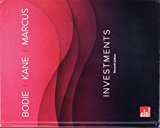
a.
To calculate: The implied 1-year forward rate for default free zero coupon bonds.
Introduction:
Implied forward rate: Normally we come across a difference of amount between the spot interest rates and the forward interest rate. This difference can be termed as implied forward rate. Implied forward rate helps the investors to compare the returns across investments.
b.
To calculate: The yield to maturity on 1-year zero-coupon bonds next year, assuming that pure expectations hypothesis of the term structure is correct.
Introduction:
Yield to maturity: Whenever an investment is made by the investor, he/she is entitled to earn return for holding the security or bonds till it matures. When this return is calculated in percentages, it is called yield to maturity.
c.
To calculate: The yield on 2-year zeros.
Introduction:
Zero-coupon bond: It is a type of bond where the face value of the bond is repaid at the time of maturity. In simple words, since no periodic interest payments or coupon payments are made on bonds, it is termed as zero-coupon bond.
d.
To calculate: The expected total
Introduction:
Total return: It is supposed to be the rate of
e.
To calculate: The expected total rate of return over the next 3-year zero coupon bond.
Introduction:
Total return: It is supposed to be the rate of return on investment for a given period. It includes capital gains, dividends, interest and distributed realized earnings for a given period.
f.
To calculate: The current price of a 3-year maturity bond with 12% coupon rate which is paid annually.
Introduction:
g.
To calculate: The total expected rate of return over the next year.
Introduction:
Expected rate of return: When an investment is made, the investor expects or anticipates some return. The rate at which this anticipated or expected returns are earned is called expected rate of return. It is also called as anticipated rate of return.
Trending nowThis is a popular solution!

Chapter 15 Solutions
Investments, 11th Edition (exclude Access Card)
- The value of an investment grows from $10,000 to $15,000 in 3 years. What is the CAGR?arrow_forwardYou invest $5,000 in a project, and it generates $1,250 annually. How long will it take to recover your investment?arrow_forwardA company pays an annual dividend of $3 per share, and the current stock price is $50. What is the dividend yield?arrow_forward
- You invest $1,000 in a stock, and after 2 years, it grows to $1,200. What is the annual return?arrow_forwardYou invest $1,000 in a stock, and after 2 years, it grows to $1,200. What is the annual return? Exparrow_forwardWells and Associates has EBIT of $ 72800. Interest costs are $ 18400, and the firm has 15600 shares of common stock outstanding. Assume a 40 % tax rate. a. Use the degree of financial leverage (DFL) formula to calculate the DFL for the firm. b. Using a set of EBIT -EPS axes, plot Wells and Associates' financing plan. c. If the firm also has 1200 shares of preferred stock paying a $ 5.75 annual dividend per share, what is the DFL? d. Plot the financing plan, including the 1200 shares of $ 5.75 preferred stock, on the axes used in part (b). e. Briefly discuss the graph of the two financing plans.arrow_forward
- You invest $5,000 for 3 years at an annual interest rate of 6%. The interest is compounded annually. Need helparrow_forwardWhat is the future value of $500 invested for 3 years at an annual compound interest rate of 4%? Explarrow_forwardYou invest $5,000 for 3 years at an annual interest rate of 6%. The interest is compounded annually.arrow_forward
- What is the future value of $500 invested for 3 years at an annual compound interest rate of 4%?arrow_forwardA loan of $10,000 is taken at an annual interest rate of 6% for 5 years. What is the total interest payable under simple interest? Expalarrow_forwardA loan of $10,000 is taken at an annual interest rate of 6% for 5 years. What is the total interest payable under simple interest?arrow_forward
 Intermediate Financial Management (MindTap Course...FinanceISBN:9781337395083Author:Eugene F. Brigham, Phillip R. DavesPublisher:Cengage Learning
Intermediate Financial Management (MindTap Course...FinanceISBN:9781337395083Author:Eugene F. Brigham, Phillip R. DavesPublisher:Cengage Learning
